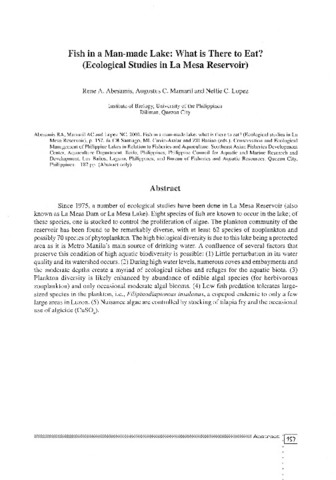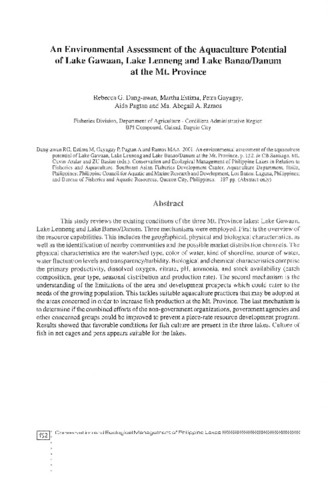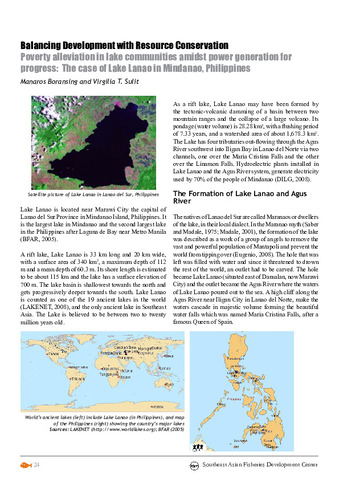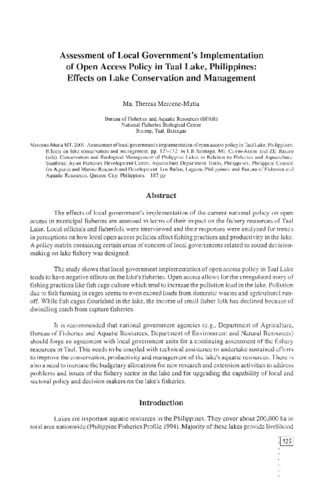Fish in a man-made lake: what is there to eat? (Ecological studies in La Mesa Reservoir)
Share
Abstract
Since 1975, a number of ecological studies have been done in La Mesa Reservoir (also known as La Mesa Dam or La Mesa Lake). Eight species of fish are known to occur in the lake; of these species, one is stocked to control the proliferation of algae. The plankton community of the reservoir has been found to be remarkably diverse, with at least 62 species of zooplankton and possibly 70 species of phytoplankton. The high biological diversity is due to this lake being a protected area as it is Metro Manila's main source of drinking water. A confluence of several factors that preserve this condition of high aquatic biodiversity is possible: (1) Little perturbation in its water quality and its watershed occurs. (2) During high water levels, numerous coves and embayments and the moderate depths create a myriad of ecological niches and refuges for the aquatic biota. (3) Plankton diversity is likely enhanced by abundance of edible algal species (for herbivorous zooplankton) and only occasional moderate algal blooms. (4) Low fish predation tolerates large-sized species in the plankton, i.e., Filipinodiaptomus insulanus, a copepod endemic to only a few large areas in Luzon. (5) Nuisance algae are controlled by stocking of tilapia fry and the occasional use of algicide (CuSO4).
Description
Abstract only.
Suggested Citation
Abesamis, R. A., Mamaril, A. C., & Lopez, N. C. (2001). Fish in a man-made lake: what is there to eat? (Ecological studies in La Mesa Reservoir) (Abstract only). In C. B. Santiago, M. L. Cuvin-Aralar, & Z. U. Basiao (Eds.), Conservation and Ecological Management of Philippine Lakes in Relation to Fisheries and Aquaculture (p. 157). Tigbauan, Iloilo, Philippines: Aquaculture Department, Southeast Asian Fisheries Development Center; Los Baños, Laguna, Philippines: Philippine Council for Aquatic and Marine Research and Development (PCAMRD), Department of Science and Technology; Quezon City, Philippines: Bureau of Fisheries and Aquatic Resources (BFAR), Department of Agriculture, Quezon City, Philippines.
Subject
Related items
Showing items related by title, author, creator and subject.
-
An environmental assessment of the aquaculture potential of Lake Gawaan, Lake Lenneng and Lake Banao/Danum at the Mt. Province
Dang-awan, Rebecca G.; Estima, Martha; Gayagay, Petra; Pagtan, Aida; Ramos, Ma. Abegail A. (Aquaculture Department, Southeast Asian Fisheries Development Center; Philippine Council for Aquatic and Marine Research and Development (PCAMRD), Department of Science and Technology; Bureau of Fisheries and Aquatic Resources, 2001)This study reviews the existing conditions of the three Mt. Province lakes: Lake Gawaan, Lake Lenneng and Lake Banao/Danum. Three mechanisms were employed. First is the overview of the resource capabilities. This includes ... -
Balancing development with resource conservation poverty alleviation in lake communities amidst power generation for progress: The case of lake Lanao in Mindanao, Philippines
Boransing, Manaros; Sulit, Virgilia T. (Secretariat, Southeast Asian Fisheries Development Center, 2009) -
Assessment of local government's implementation of open access policy in Taal Lake, Philippines: Effects on lake conservation and management
Mercene-Mutia, Ma. Theresa (Aquaculture Department, Southeast Asian Fisheries Development Center; Philippine Council for Aquatic and Marine Research and Development (PCAMRD), Department of Science and Technology; Bureau of Fisheries and Aquatic Resources, 2001)The effects of local government's implementation of the current national policy on open access in municipal fisheries are assessed in terms of their impact on the fishery resources of Taal Lake. Local officials and fisherfolk ...





